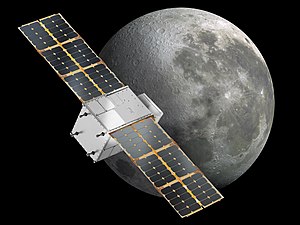 Illustration of the Cislunar Autonomous Positioning System Technology Operations and Navigation Experiment (CAPSTONE) | |
| Names | Cislunar Autonomous Positioning System Technology Operations and Navigation Experiment |
|---|---|
| Mission type | Technology demonstration |
| Operator | Advanced Space[1] |
| COSPAR ID | 2022-070A |
| SATCAT no. | 52914 |
| Mission duration | Planned: 10 months Elapsed: 2 years, 4 months and 25 days |
| Spacecraft properties | |
| Spacecraft | CAPSTONE |
| Spacecraft type | 12U CubeSat |
| Bus | CubeSat |
| Manufacturer | Advanced Space (management) Tyvak Nano-Satellite Systems (bus) Stellar Exploration, Inc (propulsion) |
| Launch mass | 25 kg (55 lb)[2][3] |
| Start of mission | |
| Launch date | 28 June 2022, 09:55 UTC[2] |
| Rocket | Electron/Photon HyperCurie |
| Launch site | Mahia, LC-1B[4] |
| Contractor | Rocket Lab |
| Moon orbiter | |
| Orbital insertion | 14 November 2022, 00:38 UTC |
| Orbits | Near-rectilinear halo orbit (NRHO)[3] |
| Orbital parameters | |
| Periselene altitude | 1,500 km (930 mi) |
| Aposelene altitude | 70,000 km (43,000 mi) |
| Inclination | Elliptic polar orbit |
CAPSTONE (Cislunar Autonomous Positioning System Technology Operations and Navigation Experiment) is a lunar orbiter that is testing and verifying the calculated orbital stability planned for the Lunar Gateway space station. The spacecraft is a 12-unit CubeSat that is also testing a navigation system that is measuring its position relative to NASA's Lunar Reconnaissance Orbiter (LRO) without relying on ground stations. It was launched on 28 June 2022, arrived in lunar orbit on 14 November 2022, and was scheduled to orbit for six months. On 18 May 2023, it completed its primary mission to orbit in the near-rectilinear halo orbit for six months, but will stay on this orbit, continuing to perform experiments during an enhanced mission phase.[5]
- ^ "CAPSTONE". Advanced Space. Retrieved 15 November 2022.
- ^ a b "CAPSTONE". NASA Space Science Data Coordinated Archive. Retrieved 9 February 2023.
- ^ a b Cite error: The named reference
sfn-20200215was invoked but never defined (see the help page). - ^ Cite error: The named reference
rl-20210806was invoked but never defined (see the help page).